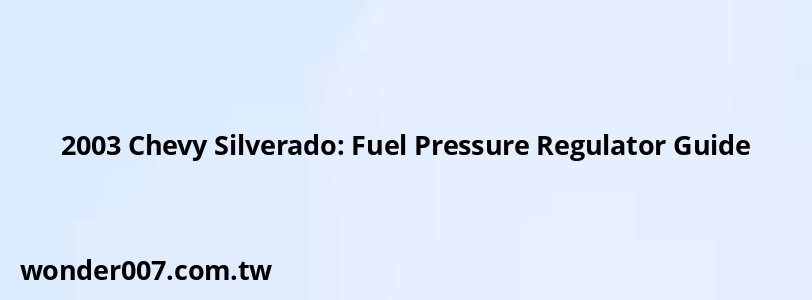2003 Chevy Silverado: Fuel Pressure Regulator Guide

The fuel pressure regulator is a crucial component in the fuel system of the 2003 Chevy Silverado. Understanding its function, symptoms of failure, and replacement process can help owners maintain their vehicles effectively. This guide is tailored for Silverado owners who may be experiencing fuel system issues or are looking to perform maintenance.
Understanding the Fuel Pressure Regulator
The fuel pressure regulator ensures that the fuel injectors receive a consistent fuel supply at the correct pressure. It plays a vital role in maintaining the appropriate air-fuel mixture for optimal engine performance. A malfunctioning regulator can lead to various engine issues, including stalling, poor acceleration, and increased emissions.
Symptoms of a Faulty Fuel Pressure Regulator
Recognizing the signs of a failing fuel pressure regulator is essential for timely repairs. Common symptoms include:
- Engine misfires or rough idle
- Stalling at idle or during acceleration
- Fuel leakage from the vacuum line
- Blackened spark plug electrodes
- Poor fuel economy
If you notice any of these symptoms, it’s crucial to address the issue promptly to prevent further damage to your engine.
Replacement Process
Replacing the fuel pressure regulator in a 2003 Chevy Silverado can be done with basic tools and some mechanical knowledge. Follow these steps for a successful replacement:
Materials Needed
- Flat head screwdriver
- Needle nose pliers
- O-ring pick
- Shop rags
- New fuel pressure regulator (ensure it comes with O-rings)
Step-by-Step Instructions
1. Prepare the Vehicle
- Ensure the engine is cool before starting.
- Disconnect the battery to prevent any electrical issues.
2. Relieve Fuel Pressure
- Locate the fuel pump relay in the fuse panel and remove it.
- Start the engine and let it run until it stalls, indicating that fuel pressure has been relieved.
3. Access the Regulator
- The fuel pressure regulator is located on the driver’s side of the engine near the fuel rail.
- Disconnect the vacuum line from the top of the regulator by pulling it off gently.
4. Remove the Old Regulator
- Use a flat head screwdriver to pry off the retaining clamp.
- Pull out the old regulator while placing shop rags underneath to catch any spilled fuel.
- Remove any O-rings or screens that may be stuck in place.
5. Install the New Regulator
- Lubricate the new O-rings with a small amount of motor oil for a better seal.
- Insert the new regulator into position, ensuring that it is oriented correctly.
- Reattach the retaining clamp and vacuum line.
6. Reconnect Everything
- Reinstall the fuel pump relay.
- Reconnect the battery and start your vehicle to check for leaks and ensure proper operation.
FAQs About Fuel Pressure Regulators
- How do I know if my fuel pressure regulator is bad?
Look for symptoms like stalling, misfires, or fuel leaks from the vacuum line. - Can I drive my truck with a faulty regulator?
It's best not to drive with a faulty regulator as it can cause significant engine damage. - How often should I replace my fuel pressure regulator?
Regular inspections are recommended; replace it if you notice any symptoms of failure.
Maintaining your 2003 Chevy Silverado's fuel system is essential for performance and longevity. By understanding how to identify issues with your fuel pressure regulator and knowing how to replace it, you can keep your vehicle running smoothly.
Related Posts
-
Oil Pressure Sensor: Troubleshooting and Replacement for 2008 Chevy Impala
29-01-2025 • 201 views -
2007 Hyundai Santa Fe Windshield Wiper Guide
28-01-2025 • 204 views -
Ford 5.4 Coolant Temp Sensor Location Guide
26-01-2025 • 205 views -
Fuse Box Diagram: 1979 Chevy Truck Guide
30-01-2025 • 159 views -
2017 Hyundai Tucson: AC Relay Location and Guide
30-01-2025 • 174 views
Latest Posts
-
How To Turn Off Paddle Shifters Mercedes
01-02-2025 • 387 views -
2015 Chevy Traverse AC Recharge Port Location
01-02-2025 • 417 views -
Rear Brake Caliper Piston Won't Compress
01-02-2025 • 361 views -
Are O2 Sensors Covered Under Warranty
01-02-2025 • 378 views -
Power Steering Fluid Leak On Passenger Side
01-02-2025 • 461 views
Popular Posts
-
Toyota Hiace: Fuel Efficiency Insights for 2025
26-01-2025 • 645 views -
EPC Light: Understanding Causes and Solutions
26-01-2025 • 1065 views -
Power Steering and ABS Light On: Causes and Solutions
27-01-2025 • 649 views -
V12 Engine Costs: What You Need to Know
26-01-2025 • 688 views -
Hino Warning Lights: Understanding Dashboard Alerts
26-01-2025 • 794 views
